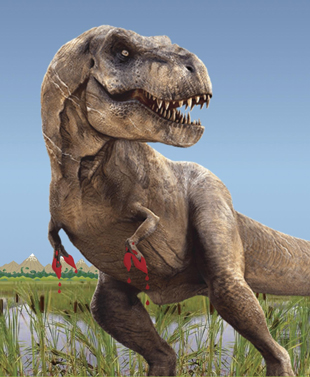
Tyrannosaurus rex may have had small arms, but it was no pushover. For more than a century, many paleontologists have viewed the small arms of T. rex as having been vestigial—features left over from evolutionary past, but no longer useful. At over three feet long, these arms were not as tiny as often portrayed, and their traits indicate that they were actually well-adapted for vicious slashing at close quarters, paleontologist Steven Stanley of the University of Hawaiʻi at Mānoa Department of Geology and Geophysics said at the recent Geological Society of America meeting.
This fierce dinosaur is known for its giant head, powerful jaws and overall fearsome appearance—except for those arms. Tyrannosaur ancestors used long arms primarily for grasping. These atrophied during the evolution that led to the tyrannosaurids because the jaws took over their grasping function. No longer being selected for, the arms were selected against. As the arms approached their final size, natural selection kicked in and made both their bones and their muscles very strong and able to withstand the impact of slashing.
“The arms seem small in relation to the huge size of their possessors, and I think this has misled people,” said Stanley. “Also, the fact that the arms did atrophy has led people to assume that they were puny, but they were not. This considerable strength has been known for about 35 years, but people have overlooked it. Because it’s been largely ignored, I myself only recently learned of the evidence that the arms were strong. This got me to analyzing them.”
Stanley continued to put the pieces together. In addition to strength, he noted each arm ended in two sharp claws about four inches long. Two claws give more slashing power than three, because each one can apply heavier pressure. Furthermore, the edges of the claws are beveled and sharp like those of a bear rather than flat like the grasping claws of an eagle. Lastly, the humoral head was part of an unusual quasi-ball-and-socket joint that would have provided considerable mobility for slashing. These traits support the slasher hypothesis, he concluded.
Having been huge and warm-blooded, T. rex would have needed very large meals. It is generally agreed that it would have eaten other dinosaurs. The most abundant large ones would have been a formidable opponent.
—By Marcie Grabowski

